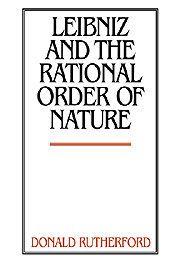Book contents
- Frontmatter
- Contents
- Acknowledgments
- A Note on Citations and Translations
- Abbreviations
- Introduction
- Part I Theodicy
- Part II First Philosophy
- Part III Nature
- 7 Modeling the Best of All Possible Worlds
- 8 Monads, Matter, and Organisms
- 9 Dynamics and the Reality of Matter
- 10 Corporeal Substance and the Union of Soul and Body
- Conclusion
- Bibliography
- Index
7 - Modeling the Best of All Possible Worlds
Published online by Cambridge University Press: 05 June 2012
- Frontmatter
- Contents
- Acknowledgments
- A Note on Citations and Translations
- Abbreviations
- Introduction
- Part I Theodicy
- Part II First Philosophy
- Part III Nature
- 7 Modeling the Best of All Possible Worlds
- 8 Monads, Matter, and Organisms
- 9 Dynamics and the Reality of Matter
- 10 Corporeal Substance and the Union of Soul and Body
- Conclusion
- Bibliography
- Index
Summary
The defining thought of Leibniz's theodicy is that from among an infinity of possible worlds God has chosen for existence the one that is the best of all possible worlds, or the possible world of greatest perfection. We saw in Part I that Leibniz conceives of this perfection as closely connected with the values of variety, order, and harmony. Broadly, his view is that God selects for creation the world that realizes the greatest harmony, by virtue of containing the greatest possible variety of beings united by the optimal order.
The aim of the final part of this book is to establish a link between this abstract account of the best of all possible worlds and the details of Leibniz's metaphysics. At stake here is an issue critical to the project of theodicy. If the characteristics of perfection, order, and harmony are those Leibniz specifically associates with this being the best of all possible worlds, and if the metaphysical theory outlined in works such as the Monadology is intended to describe the fundamental constitution of this world, then there should presumably be some relationship between the two; that is, we should be able to see how the latter theory realizes the values Leibniz says are maximized in the creation of this world. Furthermore, our being able to come to this sort of understanding of the world should be viewed, according to the interpretation advanced in Part I, as the fulfillment of our role as rational minds capable of imitating in their models of the universe God's providential plan for creation.
- Type
- Chapter
- Information
- Leibniz and the Rational Order of Nature , pp. 177 - 211Publisher: Cambridge University PressPrint publication year: 1995



